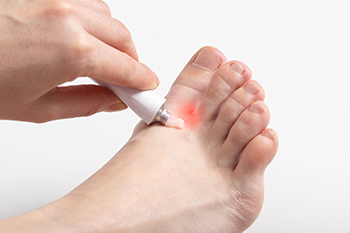Dealing With Athlete’s Foot
Tuesday, 18 July 2023 00:00
Athlete’s foot, which is a fungal infection termed tinea pedis, often causes an eruption of blisters between the toes or on the bottom of the foot. The blisters are filled with a clear liquid, which in and of itself is not problematic. Other symptoms can include scaling skin, redness, and itchiness. It is important to know that the fungus that causes athlete’s foot is extremely contagious and can easily spread to other body parts. Be sure to wash your hands after touching the infected area. Men, people who are diabetic, and anyone with eczema may be more likely to become infected with athlete’s foot. The best way to prevent coming into contact with the fungus that causes athlete’s foot is to wear foot coverings in warm and moist public areas. This includes shower rooms and locker areas at gyms and swimming pools. If an athlete's foot infection does not react to common treatments, it is suggested that you make an appointment with a podiatrist who can examine the affected foot, and test the infected area to provide appropriate treatment measures.
Athlete’s foot is an inconvenient condition that can be easily reduced with the proper treatment. If you have any concerns about your feet and ankles, contact Eveleigh Williams, DPM from Sole 2 Sole, PC. Our doctor will treat your foot and ankle needs.
Athlete’s Foot: The Sole Story
Athlete's foot, also known as tinea pedis, can be an extremely contagious foot infection. It is commonly contracted in public changing areas and bathrooms, dormitory style living quarters, around locker rooms and public swimming pools, or anywhere your feet often come into contact with other people.
Solutions to Combat Athlete’s Foot
- Hydrate your feet by using lotion
- Exfoliate
- Buff off nails
- Use of anti-fungal products
- Examine your feet and visit your doctor if any suspicious blisters or cuts develop
Athlete’s foot can cause many irritating symptoms such as dry and flaking skin, itching, and redness. Some more severe symptoms can include bleeding and cracked skin, intense itching and burning, and even pain when walking. In the worst cases, Athlete’s foot can cause blistering as well. Speak to your podiatrist for a better understanding of the different causes of Athlete’s foot, as well as help in determining which treatment options are best for you.
If you have any questions please feel free to contact our office located in Olympia Fields, IL . We offer the newest diagnostic and treatment technologies for all your foot and ankle needs.








